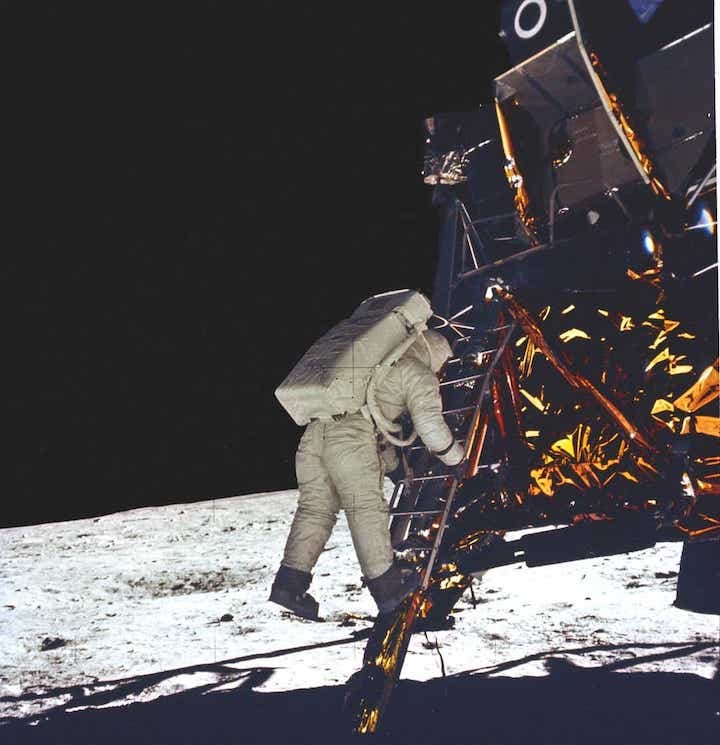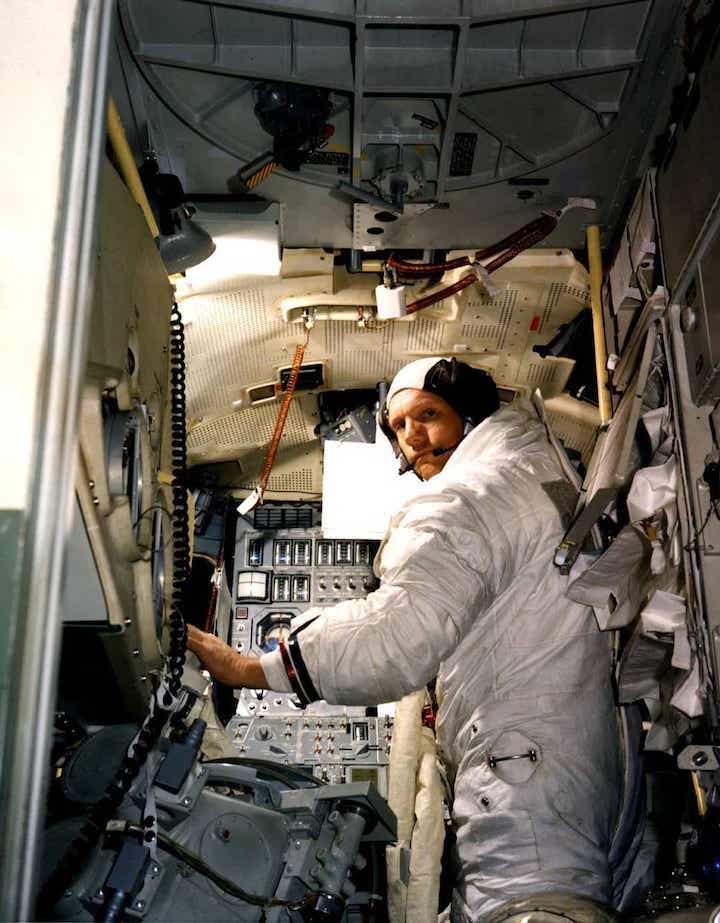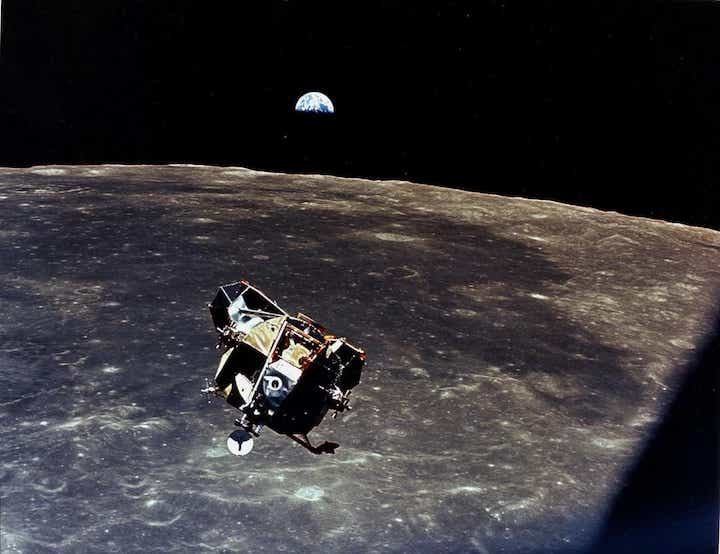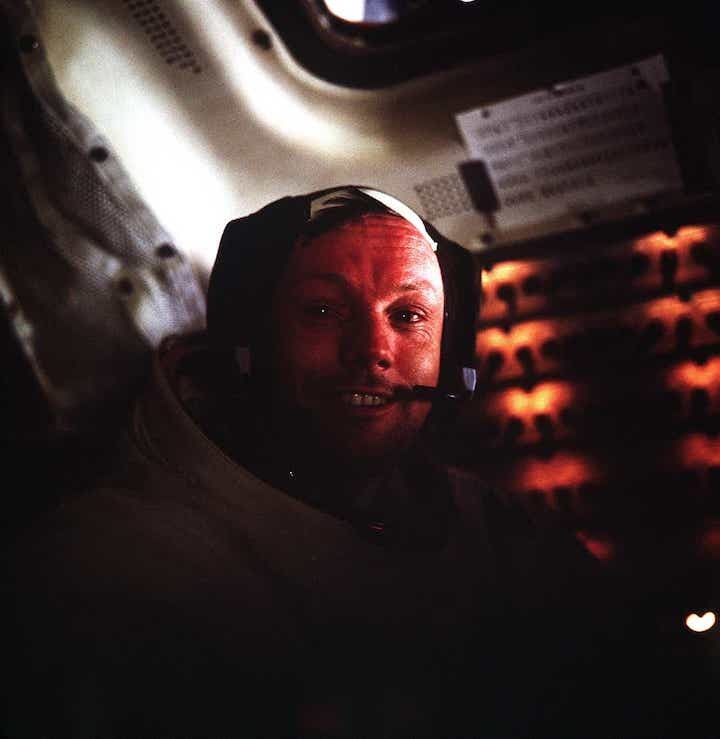19.07.2019

Fifty years ago, astronaut Neil Armstrong stepped off the ladder of the Eagle lunar module and onto the surface of the moon, the first human to do so.
Armstrong's mother Viola watched the historic moment at home on TV, along with 650 million other people around the world. Her biggest fear had been that Neil would sink down and be "swallowed up" by the moon so shortly after taking his first steps, Armstrong said "I only go in a small fraction of an inch, maybe an eighth of an inch but I can see the footprints of my boots and the treads in the fine sandy particles."
That line was for her, to ease her mind. While she and the rest of the world witnessed Armstrong bounce around kid-like on the moon's surface, they had no idea how close he was to never taking those steps.
Only hours earlier Armstrong was whizzing over the moon's surface with fellow astronaut Buzz Aldrin at 342 miles per hour on a collision course with a crater as big as a football field.
After launching from Kennedy Space Center on July 16, the journey to the moon took 4 days, 6 hours and 45 minutes. It was a nearly flawless flight until the last 7 and half minutes when unforeseen challenges threatened to derail the mission.

4:10 p.m EDT
Seconds after being cleared for the powered descent to the moon's surface, an alarm blares in the lunar module. Armstrong alerts mission control immediately, "Program alarm," followed by the alarm code, "1202." Aldrin repeats it, "1202."
No response from mission control. Back in Houston, they are scrambling to find out what the alarm means.
Armstrong and Aldrin don't know either. They had never seen it during training. Armstrong asks Aldrin, "What is it?" and then strongly requests mission control "give us a reading on the 1202 alarm." Years later, Charlie Duke from Mission Control said, "When I heard the alarm, I thought we were dead in the water."
They could still abort but they didn't want to. Afterward at a post-flight press conference, Armstrong made that clear, "We had gone that far and we wanted to land. We didn't want to practice aborts."
A 26-year-old software engineer named Jack Garman realizes it's a data overload alarm. The computer is working overtime to process the enormous amount of information but Garman quickly determines the computer issue won't jeopardize the mission.
Finally, Duke responds, "We're go on that alarm." Crisis averted. They are still headed to the moon.

4:15 p.m EDT
But the relief is short lived. Around 1,500 feet from the moon's surface, Armstrong realizes they have overshot their intended landing site by four miles and are headed for a field of boulders surrounding a giant rocky crater.
To override the programmed guidance system, Armstrong switches to manual control so he can pilot them to a safer spot. Armstrong maintains his cool demeanor but his heart rate reveals otherwise as it goes from a normal 77 beats per minute to 156.
At first, he thinks he can land before they get to the crater but then realizes they're going too fast to stop short of the hazardous rocks. He decides to risk it and keep flying past the rugged terrain but there is another problem.
4:16 p.m EDT
As Armstrong peers out the tiny window scanning the Moon's surface for a smooth landing spot, he realizes they are running low on fuel. A red warning light indicates they have 5% fuel remaining. Armstrong finally sees a spot he likes, "Looks like a good area here." But can they get there in time?
A hundred feet above the surface of the Moon, Mission Control confirms they have 60 seconds of fuel left before Armstrong has to make the decision to abort. If they run out of fuel before they land, they will crash and most likely die as there is no possibility of a rescue mission.
Charlie Mars, a NASA engineer at Kennedy Space Center during the Apollo era, remembers the moment vividly, "We‘re all in a room, we’re all listening to them coming down and we just held our breath and I ended up looking at my boss, for some reason, he was at the other table, our eyes locked for about the last minute. I don’t think we breathed for the last minute. Nobody in the room breathed for the last minute."
Thirty seconds of fuel left. As Armstrong inches closer and closer to the Moon's surface, Aldrin reads out their altitude and speed:
"40 feet down, picking up some dust."
"30 feet, faint shadow"
"20 feet..."
"Contact light"
And then from Armstrong: "Houston, Tranquility Base here. The Eagle has landed."
4:17 p.m. EDT
After 102 hours, 45 minutes and 39 seconds of flight, the Eagle lands on the moon with about 20 seconds of descent fuel left. As the world took a collective breath, Armstrong and Aldrin simply shook hands and smiled. From mission control, Duke speaks for everyone when he says, "We copy you on the ground. You got a bunch of guys about to turn blue. We're breathing again. Thanks a lot."
Contact Rachael Joy at 321-242-3577 or email rjoy@floridatoday.com. Follow her on Twitter @Rachael_Joy.


